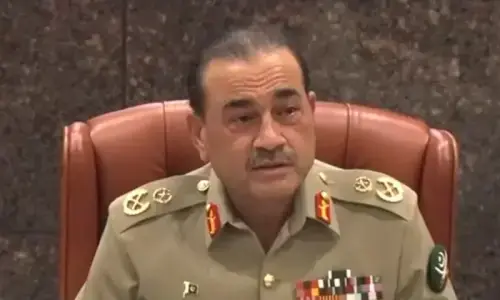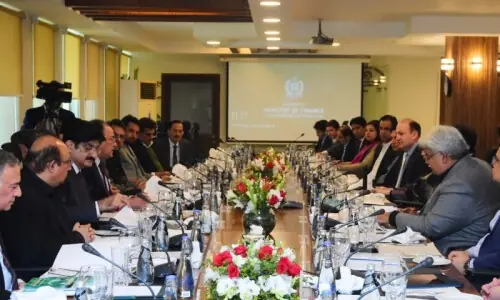
It favoured greater autonomy to the provinces but it turned in favour of a strong and assertive centre in the post-independence period.
The resolution for the establishment of a separate homeland for the Muslims of British India passed in the annual session of the All India Muslim League held in Lahore on 22-24 March 1940 is a landmark document of Pakistan’s history.
The passing of the resolution marked the transformation of the Muslim minority in British India into a nation with its distinguishing socio-cultural and political features, a sense of history and shared aspirations for the future within a territory.
The Lahore Resolution, popularly described as the Pakistan Resolution, employs modern political discourse for putting forward its demand rather than using a religious idiom for creating a religious-Islamic state for protection of Islam from the onslaught of other religions of India.
It made worldly demand keeping in view the peculiar problems of the Muslims of British India, the political experience of the Muslim community and the prevailing debate about the ways to protect Muslim identity, rights and interests against the backdrop of the modern state system established by the British in India.
The Resolution addressed the Muslim question in the political and constitutional context of British India and pointed out to the course of action the Muslim League intended to adopt to secure the Muslim identity, rights and interests.
It emphasized the principles that were relevant to modern state system and the political context of British India. It made five specific demands:
1. The Resolution rejected the federal system of government as envisaged in the Government of India Act, 1935 because it was “totally unsuited to and unworkable in the peculiar conditions of this country and is altogether unacceptable to Muslim India.”
2. The Muslims would not accept any revised constitutional plan unless it was framed with “their consent and approval.”
3. The adjacent territorial units should be demarcated into regions that may involve some territorial adjustments in a manner “that the areas in which the Muslims are numerically in a majority as in north-western and eastern zones of India “become “independent states in which the constituent units shall be autonomous and sovereign.”
4. The resolution offered “adequate, effective and mandatory safeguards for religious minorities” in the Muslim majority units for the “protection of their religious, cultural, economic, political, administrative and other rights and interests in consultation with them.” Similar rights will be given to the Muslims in “other parts of India.” 5. The Muslim League Working Committee was asked to formulate a constitutional scheme on the basis of the principles outlined in the Resolution.
The Resolution thus offered a new course of action for the Muslims of British India as compared to the Muslim League position adopted on constitutional and political issues in the past.
The change was that of strategy but not of the goal.
The Muslim League goal since its inception in December 1906 was to protect and advance Muslim socio-cultural identity, rights and interests in British India’s socio-political and constitutional context.
Initially the Muslim League demanded separate electorate for the Muslims so that they could elect their representatives.
Later, it sought adequate Muslim representation in the cabinets and state services/jobs.
It also demanded constitutional safeguards and guarantees for the Muslims.
It supported federalism with autonomy for provinces, hoping that the Muslims would be able to exercise power effectively in the Muslim majority provinces which would not only boost the Muslim community but also provide greater opportunity for advancement of Muslim rights and interests.
The change of strategy was caused by the political experience of the Muslim elite in their interaction with other communities, especially the Congress Party, and the policies of the British government.
These strategies also manifested the growing desire of the Muslims to assert their separate socio-political identity.
The Muslim League began to think about discarding the federal model in 1938, when the Sindh Provincial Muslim League proposed that the All India Muslim League needed to review its position on constitutional issues in view of the experience of the Muslims under the Congress governments in some provinces (1937-39).
What weakened Muslim League’s confidence in the federal model for the whole of India was the bitter experience of the Muslim educated classes and urban population under the Congress ministries in the provinces.
The cultural and educational policies of these ministries alienated the Muslims.
The Muslim elite in these and non-Congress provinces came to the conclusion that the Congress governments in the provinces were imposing Hindu ethos in the name of Indian identity.
Further the Muslim leaders complained about the discriminatory policy for recruitment of Muslims to government jobs and they maintained that the Muslims suffered in the economic domain in the Congress-ruled provinces.
The experience of the Congress rule in the provinces was the triggering factor that led the Muslim League leaders to explore a political alternative to a single Indian federation.
Though the Lahore Resolution talked of a Muslim homeland, Quaid-i-Azam Muhammad Ali Jinnah did not wholly give up the idea of some political accommodation within the framework of a loose federal model.
The Muslim League acceptance of the Cabinet Mission Plan (March -April 1946) clearly showed that its leaders were willing to work within a loose federal model that grouped the Muslim majority provinces into two political groups and non-Muslim majority provinces were put together as the third group.
These three groups were joined together under a weak federal order.
The provinces in each group could review their relationship with each other and the federal government after ten years.
The Muslim League withdrew its acceptance of the Cabinet Mission Plan when it learnt that the Congress was only interested in getting into the constituent assembly without giving any specific commitment that the future constitution would be based on the provisions of the Cabinet Mission Plan.
The Lahore Resolution did not use the name “Pakistan” in the text and it did not link up the demand with Islam.
The Resolution presented the Muslim demand in the context of British Indian politics rather than giving a constitutional framework for a proposed Muslim homeland.
The Muslim League used Islam and made Islam-based appeals for political mobilization for the 1946 provincial elections.
A large number of people and rural-based Islamic clergy, pirs and sajjadanasheens in the Punjab, Sindh and NWFP (Khyber-Pakhtunkhwa) joined the Muslim League after 1940, especially during 1945-47.
Some of the rural clergy helped the Muslim League in its election campaign. Most of them believed and advocated that Pakistan would have an Islam based political system.
There is a territorial basis of the Lahore Resolution and its demand for a Muslim homeland.
This demand became credible because of territorial contiguity of Muslim majority provinces in Northwest and Eastern zone where Bengal and some of its adjoining areas made it possible to put forward this demand.
Had the Muslim majority provinces been scattered the homeland demand would not have worked.
The Muslim League leadership was invoking the imperatives of modern state that included people, territory, government and sovereignty.
The Lahore Resolution has been a basis of three debates in the pre- and post- independence periods.
The first debate relates to the non-use of the name Pakistan in the demand.
The Hindu press and leaders were quick to describe the resolution as the demand for the creation of Pakistan; some people began to call it the Pakistan Resolution soon after the Lahore session of the Muslim League.
The second debate focuses on the use of certain terms in the Resolution.
These include “independent states” and that the constituent units will be “autonomous and sovereign.”
Was the Lahore Resolution talking of one or more than one state for the Muslims of British India?
These ambiguities can be addressed if a literalist approach is not adopted to understand the Lahore Resolution.
Rather, it has to be viewed in the political context of British India in and around 1940 and the Muslim political experience over time.
In a federal system sovereignty is the prerogative of the federal government and its constituent units cannot be both “autonomous and sovereign” at the same time.
In the case of Pakistan, the British government transferred power and authority to the state of Pakistan through its federal government established in Karachi.
Pakistani provinces got power from the federal state and the first Interim Constitution.
Pakistan’s federal system was not created by the provinces deciding to set up a federation.
Pakistan’s federation was built into the Indian Independence Act, passed in July 1947 by the British Parliament and the First Interim Constitution.
This envisaged a strong centre and weak provinces.
This legacy has haunted Pakistan’s political system from the early years.
The Pakistan movement developed gradually.
It did not stop with the passage of the Lahore Resolution.
Next seven years were important to understand the making of Pakistan.
The Muslim League demands became more specific and assertive in the post-1940 period.
By 1942, the Muslim League focus shifted to a singular phrase of state.
In September 1944 Jinnah was very categorical in asserting that he was taking of one state of Pakistan.
This issue was finally clarified by the convention of Pakistani parliamentarians held in Delhi in April 1946.
The evolutionary process of the movement for the creation of Pakistan began before March 1940 and ended with the attainment of independence in Pakistan in 1947.
The third political debate relates to the post-independence period.
Some regional-nationalist leaders in Sindh and Balochistan invoke the Lahore Resolution for seeking maximum autonomy for provinces.
They demand that Pakistan’s federal model should be based on the Lahore Resolution. Some leaders have talked of turning Pakistan into a confederation.
This is a literalist interpretation of the Lahore Resolution which can be described as flawed.
The Lahore Resolution did not offer a framework for organizing the Pakistani state, especially the distribution of powers between the federal government and provinces.
It addressed the constitutional issues in an all-India framework and offered a framework to settle the Hindu-Muslim question on a permanent basis.
The demand for greater autonomy can be raised by political parties and leaders in Pakistan with reference to the Muslim League’s political disposition on federalism in the pre-independence period.
It favoured greater autonomy to the provinces but it turned in favour of a strong and assertive centre in the post-independence period.
The 18th constitutional amendment marks the beginning of the era of greater administrative and financial autonomy for provinces.
Provinces have more control over their finances and natural resources.
If democracy continues to function and the federal and provincial governments improve their performance the confidence of people in the state system will improve.
This will weaken the role of regionalist-nationalist leaders and they will find it more difficult to invoke the Lahore Resolution for seeking more provincial autonomy.
The writer is Professor Emeritus, Political Science, Punjab University, Lahore, and a recipient of the Presidential Award Sitara-i-Imtiaz.

































